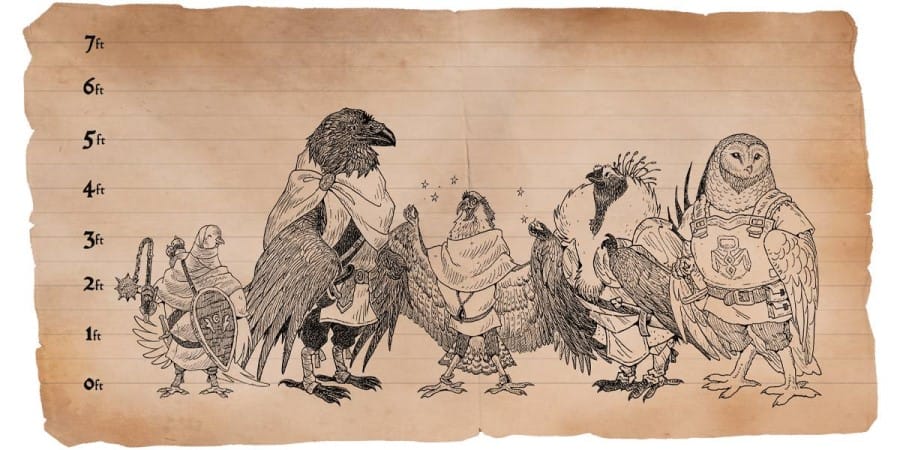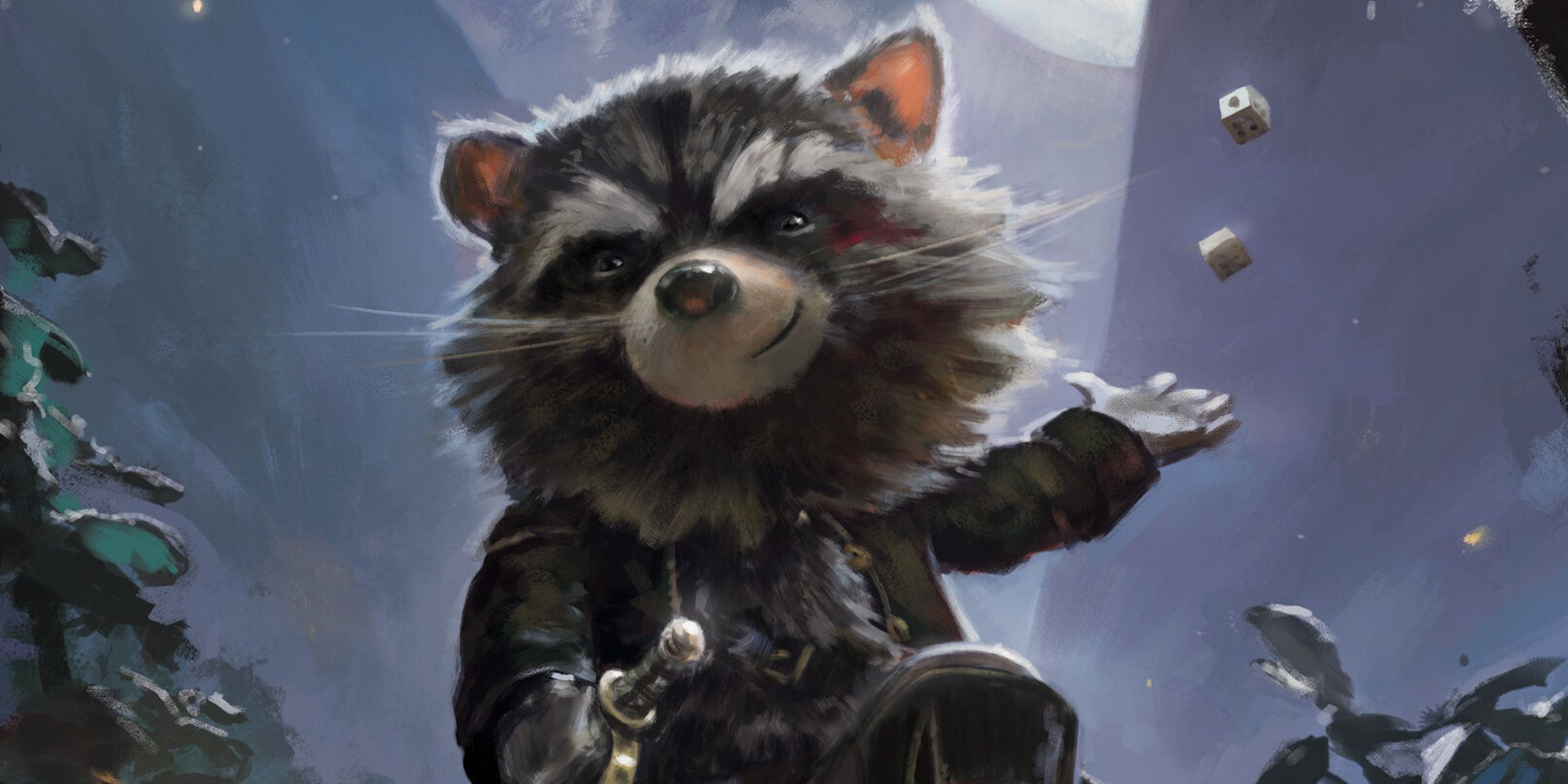Mar 4, 2024 8:13 pm
Humblewood has 10 new playable races



The table below can be used to decide your character’s height and weight. These are based on the information provided in each race’s description, and reflect the natural variation that occurs within the different folk of the Wood.
To use this table, first locate your character’s race, and roll for their height modifier. Add this result in inches to the base height shown in the previous column. Next, using the appropriate column, roll for your weight modifier. Some races have a flat weight modifier. If this is the case, simply use the number provided in this column. Then, take the number you rolled for the height modifier, and multiply it by the weight modifier. Add this result in pounds to your race’s base weight.
You may notice that the weights for birdfolk races are significantly lower than for humblefolk of similar size. The birdfolk have hollow bones, reinforced by special internal structures that act as struts. Along with other weight-reducing adaptations, this allows birdfolk to glide. Birdfolk characters are not negatively impacted by their lower weight.
[ +- ] Races of the Wood
The various folk who make up the world of Humblewood are divided into two categories: the birdfolk and the humblefolk. While they resemble animals, the folk who inhabit the cities, towns, and villages of Humblewood are all humanoids.
[ +- ] Birdfolk


[ +- ] Humblefolk


[ +- ] Sex and Gender
The sex or gender of a character doesn’t confer any special bonuses or penalties. Playable races do not exhibit physical characteristics based on sex, and traits such as plumage, markings, and size difference are not associated with a specific sex or gender. The most significant variations in physical appearance come down to a character’s subrace.
[ +- ] Height and Weight
The table below can be used to decide your character’s height and weight. These are based on the information provided in each race’s description, and reflect the natural variation that occurs within the different folk of the Wood.
To use this table, first locate your character’s race, and roll for their height modifier. Add this result in inches to the base height shown in the previous column. Next, using the appropriate column, roll for your weight modifier. Some races have a flat weight modifier. If this is the case, simply use the number provided in this column. Then, take the number you rolled for the height modifier, and multiply it by the weight modifier. Add this result in pounds to your race’s base weight.
You may notice that the weights for birdfolk races are significantly lower than for humblefolk of similar size. The birdfolk have hollow bones, reinforced by special internal structures that act as struts. Along with other weight-reducing adaptations, this allows birdfolk to glide. Birdfolk characters are not negatively impacted by their lower weight.
| Race | Base Height | Height Modifier | Base Weight | Weight Modifier | |
| Cervan (Grove) | 4'8" | +2d10 | 110 lb. | x (1d4) lb. | |
| Cervan (Pronghorn) | 6'1" | +2d10 | 120 lb. | x (2d4) lb. | |
| Corvum | 4'4" | +2d10 | 70 lb. | x (1d4) lb. | |
| Gallus | 3'4" | +3d10 | 55 lb. | x (1d4) lb. | |
| Hedge | 2'11" | +2d6 | 30 lb. | x (1d4) lb. | |
| Jerbeen | 2'4" | +2d4 | 20 lb. | x (1d2) lb. | |
| Luma | 2'8" | +2d4 | 25 lb. | x 1 lb. | |
| Mapach | 3'11" | +2d6 | 85 lb. | x (2d4) lb. | |
| Raptor | 2'11" | +2d6 | 25 lb. | x 1 lb. | |
| Strig | 3'10" | +2d10 | 80 lb. | x (1d6) lb. | |
| Vulpin | 4'2" | +2d10 | 80 lb. | x (2d4) lb. |
[ +- ] Altering Race Size
The sizes listed in the racial descriptions represent suggested averages of the various races. Players can adjust these sizes depending on the kind of birdfolk or humblefolk character they’d like to play. Some varieties of strig, a race that takes their physical characteristics from owls, could be smaller sized, around 3 feet tall, if desired. Similarly, raptors, a race whose physical characteristics resemble birds of prey, could reach around 5 feet in height. For the sake of simplicity we advise that, regardless of the physical measurements of a character, they follow the size category rules of their race (Medium or Small). In the lore, this can be expressed by saying that even a small strig is solid and strong, where even a taller raptor is light and agile. This will make calculating things that rely on size categories much easier, rather than having to remember which size variant a player has chosen for a race.
Alternatively, if the races presented here are too big when placed in comparison to humans in other campaign settings, size categories can be adjusted accordingly. This is entirely a matter of taste. It is recommended to do whatever makes the most sense for the kinds of worlds you’d like to build and the kinds of stories you’d like to tell.
Alternatively, if the races presented here are too big when placed in comparison to humans in other campaign settings, size categories can be adjusted accordingly. This is entirely a matter of taste. It is recommended to do whatever makes the most sense for the kinds of worlds you’d like to build and the kinds of stories you’d like to tell.
[ +- ] Variant Rule: Different Looks for Birdfolk and Humblefolk
The Wood covers a vast area of different environments. As such, birdfolk and humblefolk can showcase a variety of different forms. At the discretion of the GM, your Humblewood character may look different than other members of its race. While not exhaustive, we’ve provided examples of suitable analogs for different kinds of animals from which a playable race could take inspiration. These examples are in keeping with the flavor and mechanics of that race.
| Race | Variants |
| Cervan | Cervan characters could be imagined as elk, moose, or antelopes. Any hoofed creature with horns would fit the bill, especially those native to forest or mountainous environments. While not every cervan has horns, the ability to grow them is seen as a blessing of Cairith, and is a part of their culture. |
| Corvum | Birds which are known for their dark coloration, such as crows, blackbirds and grackles, would be a good visual fit. Despite typically being dark-feathered, a variety of colorful corvids exist. Jays, nutcrackers, and jackdaws are good examples. No matter which type of bird is being used for visual inspiration for your corvum, it is important that they have at least one black feather. Black feathers on a corvum are known as the "Mark of Gesme" and they are thought to impart some of Gesme’s reckless curiosity. |
| Gallus | Gallus characters are usually represented by land fowl of all kinds, ranging from those with small rounded bodies, suited to ground life, to those with longer proportions. Waterfowl, such as ducks or geese, could be used as visual inspiration for communities of gallus living by Humblewood’s wetlands. Other fowl, such as peacocks, could also be used. While not closely-related to fowl, herons, storks, and bitterns could be a good reference for taller, marshland-dwelling communities of gallus. Gallus characters with ostentatious, colorful plumage are generally better suited to the bright gallus subrace, while those with modest, earth-toned feathers might be better suited to the huden gallus subrace. |
| Hedge | While inspired by hedgehogs, having a hedge character based on a quilled animal that inhabits forests, such as a porcupine, would also make sense. Although they would probably not be native to Humblewood, armadillos, pangolins, or echidnas would also work. |
| Jerbeen | The jerbeens are inspired by jerboas, a kind of jumping mouse. Other small rodents with mouse-like proportions, including chinchillas, could be used for visual inspiration as well. Though a greater stretch, the jerbeen’s speed, size, and communal way of life would make them an ideal analog for races based on rabbits or hares. |
| Luma | Lumas are inspired by doves and pigeons, but their size and high charisma means that small songbirds such as chickadees, wrens, sparrows, and cardinals would also be a good fit. A bird-of-paradise could be used as well due to their focus on performance, though they might be better suited for visitors to Humblewood from more tropical regions. Birds with brighter or more decorative plumage would correspond to sera lumas, while those with more muted feathers would be better as sable lumas. |
| Mapch | Inspired by raccoons, mapach characters can reference members of the weasel family, such as ferrets and badgers. Mapachs are hearty and crafty, and possess a climbing speed, which means many members of this family, including polecats, would be good fits. |
| Raptor | Raptors take after smaller birds of prey, like falcons and hawks, but using larger species, like eagles or vultures as a reference would also work for raptor characters. Maran raptors could also take visual inspiration from seabirds, notably petrels or shearwaters, due to their swim speed. |
| Strig | Strigs usually resemble owls of all kinds. Owls comprise a very large and diverse family of birds, and examples can be found which are small, large, or unique in appearance. For larger, more intimidating strigs, the great gray owl or giant scops owl can provide a robust presence, while smaller strigs could take inspiration from the little owl, or boreal owl. Regardless of their size, stout strigs tend to be bulkier, with denser feathers, while swift strigs have more slender and streamlined bodies. |
| Vulpin | Vulpins generally look like foxes, but an alternative visual reference would be wolves, coyotes, or other hunting canines that could be commonly found in a forest environment. Vulpins should be represented as wild animals, to illustrate the duality of their sophisticated yet savage nature. Breeds of tamed dogs would not be a good fit. |
[ +- ] Language
| Language | Typical Speakers | Script |
| Birdfolk | Birdfolk, | Humblefolk Birdfolk |
| Cervan | Cervans | - |
| Hedge | Hedges | Sylvan |
| Jerbeen | Jerbeens | Birdfolk |
| Mapach | Mapachs | Mapach |
| Vulpin | Vulpins | Vulpin |










